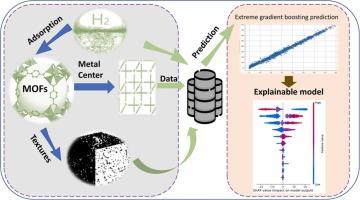预测多孔晶体材料中氢吸附的数据驱动可解释机器学习方法
IF 6.3
2区 材料科学
Q2 CHEMISTRY, PHYSICAL
引用次数: 0
摘要
氢的有效储存对于其作为可持续能源载体的采用至关重要,解决了对清洁能源日益增长的需求。多孔晶体如金属有机框架(mof)由于其高表面积、可调节的孔结构和强大的吸附能力,在潜在的存储溶液中表现出非凡的潜力。然而,优化这些材料用于实际储氢仍然具有挑战性,需要先进的预测技术来加速材料的发现和设计。本研究利用包含14,544个实验和模拟氢吸附样品的综合数据集来评估和开发先进的机器学习(ML)模型。采用极端梯度增强(XGB)、梯度增强(GRB)、支持向量回归(SVR)、多层感知器(MLP)和k近邻(KNN)五种模型,基于温度、压力、空隙率、比表面积和孔隙尺寸等特征预测氢气的吸收。XGB以最低的RMSE和最高的R²值展示了卓越的性能,确保了准确和可推广的预测。可解释的人工智能技术,特别是Shapley加法解释(SHAP),被用来解释模型,确定关键因素,如比表面积和吸附焓是氢吸收的关键驱动因素。结果强调了将ML模型与实验和计算数据集集成的优势,为设计高性能储氢材料提供了可扩展的框架。这项研究强调了机器学习在储氢优化方面的变革潜力,弥合了计算建模和材料创新之间的差距。本研究通过提高预测能力和提供可解释的见解,为发展可持续能源技术和全球碳中和倡议做出了重大贡献。本文章由计算机程序翻译,如有差异,请以英文原文为准。

Data-driven explainable machine learning approaches for predicting hydrogen adsorption in porous crystalline materials
The efficient storage of hydrogen is crucial for its adoption as a sustainable energy carrier, addressing the growing need for clean energy sources. Porous crystals such as metal-organic frameworks (MOFs) exhibit exceptional potential among potential storage solutions due to their high surface areas, tunable pore structures, and strong adsorption capacities. However, optimizing these materials for practical hydrogen storage remains challenging, requiring advanced predictive techniques to accelerate material discovery and design. This study utilizes a comprehensive dataset comprising 14,544 experimental and simulated hydrogen adsorption samples to evaluate and develop advanced machine learning (ML) models. Five models, including Extreme Gradient Boosting (XGB), Gradient Boosting (GRB), Support Vector Regression (SVR), Multi-Layer Perceptron (MLP), and K-Nearest Neighbors (KNN), were applied to predict hydrogen uptake based on features including temperature, pressure, void fraction, specific surface area, and pore dimensions. XGB demonstrated superior performance with the lowest RMSE and highest R² values, ensuring accurate and generalizable predictions. Explainable AI techniques, particularly Shapley Additive Explanations (SHAP), were employed to interpret the models, identifying critical factors such as specific surface area and adsorption enthalpy as key drivers of hydrogen uptake. The results underscore the advantages of integrating ML models with experimental and computational datasets, offering a scalable framework for designing high-performance hydrogen storage materials. This research highlights the transformative potential of ML in hydrogen storage optimization, bridging the gap between computational modeling and material innovation. This study contributes significantly to developing sustainable energy technologies and global carbon neutrality initiatives by advancing predictive capabilities and offering interpretable insights.
求助全文
通过发布文献求助,成功后即可免费获取论文全文。
去求助
来源期刊

Journal of Alloys and Compounds
工程技术-材料科学:综合
CiteScore
11.10
自引率
14.50%
发文量
5146
审稿时长
67 days
期刊介绍:
The Journal of Alloys and Compounds is intended to serve as an international medium for the publication of work on solid materials comprising compounds as well as alloys. Its great strength lies in the diversity of discipline which it encompasses, drawing together results from materials science, solid-state chemistry and physics.
 求助内容:
求助内容: 应助结果提醒方式:
应助结果提醒方式:


